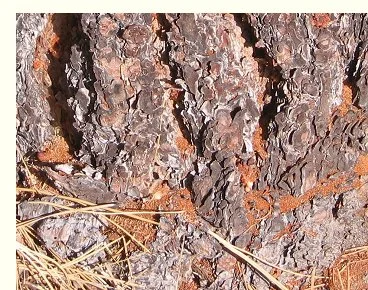Pine Beetles thrive in warm weather. Regardless of why the earth is experiencing climate chaos, the Mountain West has experienced warmer than usual winters for the past decade. Because Pine Beetles winter-over through the cold weather, and they don't die unless the temperature reaches about 30° below zero for several days, there has been very little beetle mortality in the snow season. The population has not been winnowed down each year as was the case for centuries before.
The Spring broods hatch from the "host tree" and fly to their next victim tree just as soon as the weather reaches a balmy 60+ degrees. That usually means about mid-Aparil in the lower elevations like Arizona, mid-May in lower mountain regions or end-May or early June in the higher elevations. If you live in the Southwest (New Mexico or maybe Flagstaff, Arizona), they may even fly, lay eggs, hatch and fly again in just one season.
Both New Mexico and Montana engaged in a furious battle with pine beetles in 2014, and both states have experienced repeated infestations. The New Mexico Forest Service is recommending treating twice this season: Once in Spring, and again in August to keep protection going through November and snow season. Ruidoso has been particularly hard hit. Montana added Missoula, Kalispell, and Billings to the list of hard-hit areas. And the beetles continue to move.
To make matters worse, after the trees die of mountain pine beetle infestation, the IPS beetles smell the dead trees and move in. Because the climate has been so mild over recent winters, all of the beetles are thriving.
Lodgepole Pine, Sugr Pine, White Pine, Ponderosa. Jack Pine, and Limber Pine are the most common victims of Mountain Pine Beetles, although several other species are at risk. Beetles home in on "terpines", which are pine odors that identify which trees are weak. They are also attracted to saps produced by damaged trees, and consider them desirable targets due to the tree's weakened condition. (Healthy trees are sometimes able to defeat the beetle's attempts to drill in, so weak trees are preferred.)
Given the choice, Mountain Pine Beetles choose the largest diameter trees. When those are gone, they will attack smaller trees. They continue to march (mostly the direction the wind blows) until they have gobbled themselves to the end of the trees. Colorado, which had several million acres under siege 5 years ago, is down to about 1 million active acres today due to the lack of living target trees in previously heavily infested areas. No trees, no beetles.

Female beetles attack a tree first and then release "trans verenol", a pheromone that attracts male beetles. As the males arrive, they release exo brevicomin which attracts female AND male beetles. The pheromone "cocktail" blows down wind, and brings in large numbers of beetles. This is what makes the Mountain Pine Beetle so wonderfully efficient: it's ability to mass attack one tree, defeat the trees defences and then move on to the next one (usually close by).
The Pine Beetle itself can kill a tree when the larvae eat their way ouot, gouging tunnels that effectively cut off the water supply that is carried under the bark to the top of the tree. However, there is an added culprit that also kills the tree. As the female bores into the bark and down into the sub layer where she builds a nesting chamber and lays eggs, she carries with her a fungus (known as Blue Stain Fungus) that infects the trees.
The fungi stops the tree from producing resin to pitch out or kill the beetle, thus enabling the beetles to attack and reproduce with impunity. The fungi also blocks nutrient-conducting columns, inhibiting the flow of nutrients and eventually starving the tree.
You can recognize a pine-beetle-attacked tree by its characteristic "popcorn" pitch tubes. They are wads of pitch that the tree has produced as a sort of sap trap to encase the boring beetle before it can penetrate to the phloem layer of the tree. If the sap is successful no harm is done to the tree and the beetle attack is thwarted.
Trees that are damaged and weakened by drought conditions such as the droughts concurrent with the warmer temperatures in the West, have little moisture to produce adequate pitch tubes for natural protection from the beetles.


Cutting the tree, though necessary, will not stop the beetle unless you also discard the tree properly. It must be cut up and taken to a local collection yard where they burn them. Or you must de-bark it so that the beetle larvae are exposed and dehydrate before metamorphosizing into adults. OR, buck the tree and cover the logs with heavy-duty clear or black plastic so that the sun will cook the beetles under the wrap. Chipping it with a big chip machine will also expose the beetle larvae, but fresh chips can attract Ips Beetles. Slash (branches and twigs) also attracts Ips Beetles, so unless you want to trade one scourge for another, be sure to clean up all limbs and twigs as well as the trunk.
What about dead trees?
Beetles will live through a season inside of a dead tree as easily as if it were alive.
In all cases, cut the tree before the seasonal "fly" of the beetle. You just can't save it. And it is the mother lode for the next infestation cycle. Trees with clean, round exit holes visible on the bark (look like little b-b holes) have already let loose their minions and are no longer infectious to the forest.
